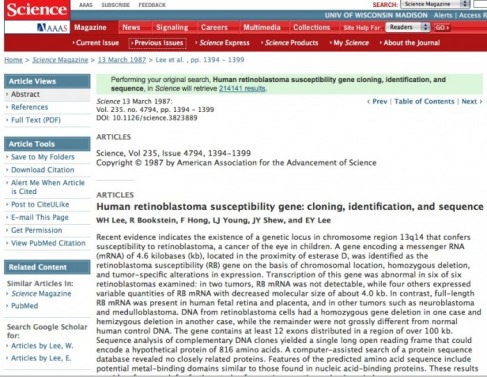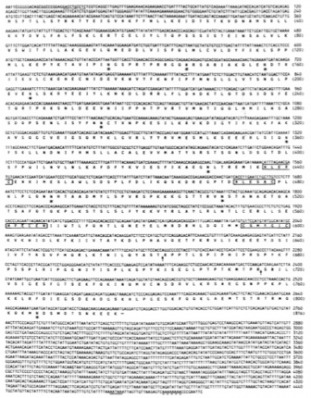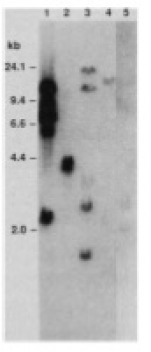This web page was produced as an assignment for Genetics 677, an undergraduate course at UW-Madison
Human Retinoblastoma Susceptibility Gene: Cloning, Identification, and Sequence
Wen-Hwa Lee, Robert Bookstein, Frank Hong, Lih-Jiuan Young, Jin-Yuh Shew, Eva Y.-H.P. Lee
Science
February 4, 1987

The main purpose of this paper was to discover where the human gene for Retinoblastoma resides, as well as sequence it. The paper describes the techniques used in order to discover the location of the gene, as well as the tests used to confirm that the gene that they had isolated was actually linked to the condition. The researchers knew that the RB1 gene resided on chromosome 13. The gene was isolated by “chromosome walking”, which is a technique used to clone a gene using it's known closest markers. After the researchers believed that they had isolated the gene, they ran several experiments in an attempt to confirm that they had the correct gene. They found strong evidence that they had in fact found the correct gene. The researchers also discovered that the RB1 gene contained at least 12 exons and could encode a hypothetical 816 amino acids.
Discovering the RB1 Gene using Chromosome Walking

The first thing that the researchers did was to attempt to discover where the RB1 gene was located using the technique known as chromosome walking. Chromosome walking is a technique used to discover the location of genes based on known closest markers. The marker that was used was the gene encoding esterase D, a gene that was known to be near the RB1 gene from previous findings. Esterase D cDNA clones, called EL-22, were used to isolate the genomic DNA near the RB1 gene. As distal DNA segments of the genomic DNA were discovered, they were then in turn used to isolate more genomic DNA in a “walking” pattern along chromosome 13. As fragments of chromosome 13 were isolated they were compared to genomic libraries that were created from Y79, which is a retinoblastoma cell line. Since the hypothesis about Retinoblastoma is that it is a recessive disease, the retinoblastoma cell line should not have expressed RB1 genes. The above figure demonstrates the technique of chromosome walking that was used.
Confirming RB1 Identity - Part 1

Once the researchers had a candidate gene for RB1, they sought to confirm it. As retinoblastoma was presumed to have recessive behavior, it would be expected that an working version of the RB1 gene should be expressed in healthy, normal retinal tissue, but not in retinoblastomas. The above figure is an RNA blot analysis of the candidate RB1 gene in tumors and normal tissues. In normal healthy retinal tissue the candidate RB1 hybridized to a 4.6 kb mRNA transcript. In the above figure, three of the six retinoblastoma samples (lanes 1,2, and 5), showed expression of altered mRNA that hybridized to the candidate RB1. These mRNA transcripts were only 4 kb long. In the other samples no mRNA is detected at all, suggesting that the RB1 gene is not being expressed at all in these tumor tissue samples. In healthy tissue, RB1 can be detected as being expressed, suggesting that this candidate gene is at least part of the putative RB gene.
Sequencing

Sequencing of the RB1 candidate gene was done using Sanger sequencing. The complete sequence was found to have 4523 nucleotides and encode a predicted 816 amino acids. The above figure shows the nucleotide and predicted amino acid sequence.
Click below for a readable version of the figure.
| rb1paperfig3.jpg | |
| File Size: | 93 kb |
| File Type: | jpg |
Confirming RB1 Identity - Part 2

As genes with important developmental functions are many times found to be conserved throughout phylogentically related organisms, the genomic DNA from four other vertebrates was examined to see if any homology existed between them and humans. Homologous sequences were detected in all five samples, with weaker hybridization intensity as evolutionary distance increased.
Lane 1: Human
Lane 2: Cow
Lane 3: Cat
Lane 4: Mouse
Lane 5: Chicken
References
1. Lee et. al. (February 4, 1987). Human Retinoblastoma Susceptibility Gene: Cloning Identification, and Sequence. http://www.sciencemag.org/cgi/content/abstract/sci;235/4794/1394
Justin Lengfeld
[email protected]
Genetics 677
Last Update: 5/13/09
